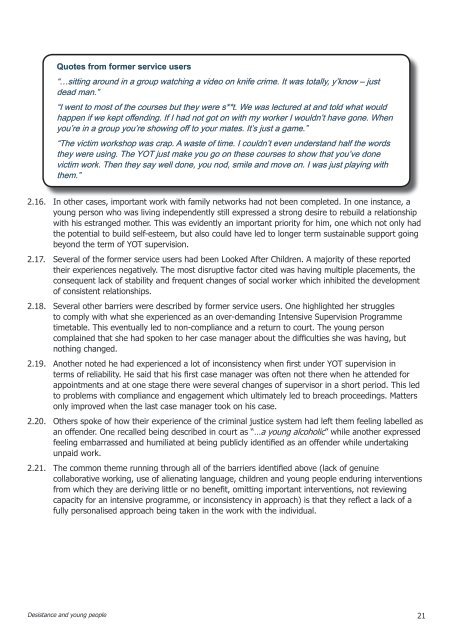Desistance and young people
Desistance_and_young_people
Desistance_and_young_people
Create successful ePaper yourself
Turn your PDF publications into a flip-book with our unique Google optimized e-Paper software.
Quotes from former service users<br />
“…sitting around in a group watching a video on knife crime. It was totally, y’know – just<br />
dead man.”<br />
“I went to most of the courses but they were s**t. We was lectured at <strong>and</strong> told what would<br />
happen if we kept offending. If I had not got on with my worker I wouldn’t have gone. When<br />
you’re in a group you’re showing off to your mates. It’s just a game.”<br />
“The victim workshop was crap. A waste of time. I couldn’t even underst<strong>and</strong> half the words<br />
they were using. The YOT just make you go on these courses to show that you’ve done<br />
victim work. Then they say well done, you nod, smile <strong>and</strong> move on. I was just playing with<br />
them.”<br />
2.16. In other cases, important work with family networks had not been completed. In one instance, a<br />
<strong>young</strong> person who was living independently still expressed a strong desire to rebuild a relationship<br />
with his estranged mother. This was evidently an important priority for him, one which not only had<br />
the potential to build self-esteem, but also could have led to longer term sustainable support going<br />
beyond the term of YOT supervision.<br />
2.17. Several of the former service users had been Looked After Children. A majority of these reported<br />
their experiences negatively. The most disruptive factor cited was having multiple placements, the<br />
consequent lack of stability <strong>and</strong> frequent changes of social worker which inhibited the development<br />
of consistent relationships.<br />
2.18. Several other barriers were described by former service users. One highlighted her struggles<br />
to comply with what she experienced as an over-dem<strong>and</strong>ing Intensive Supervision Programme<br />
timetable. This eventually led to non-compliance <strong>and</strong> a return to court. The <strong>young</strong> person<br />
complained that she had spoken to her case manager about the difficulties she was having, but<br />
nothing changed.<br />
2.19. Another noted he had experienced a lot of inconsistency when first under YOT supervision in<br />
terms of reliability. He said that his first case manager was often not there when he attended for<br />
appointments <strong>and</strong> at one stage there were several changes of supervisor in a short period. This led<br />
to problems with compliance <strong>and</strong> engagement which ultimately led to breach proceedings. Matters<br />
only improved when the last case manager took on his case.<br />
2.20. Others spoke of how their experience of the criminal justice system had left them feeling labelled as<br />
an offender. One recalled being described in court as “…a <strong>young</strong> alcoholic” while another expressed<br />
feeling embarrassed <strong>and</strong> humiliated at being publicly identified as an offender while undertaking<br />
unpaid work.<br />
2.21. The common theme running through all of the barriers identified above (lack of genuine<br />
collaborative working, use of alienating language, children <strong>and</strong> <strong>young</strong> <strong>people</strong> enduring interventions<br />
from which they are deriving little or no benefit, omitting important interventions, not reviewing<br />
capacity for an intensive programme, or inconsistency in approach) is that they reflect a lack of a<br />
fully personalised approach being taken in the work with the individual.<br />
<strong>Desistance</strong> <strong>and</strong> <strong>young</strong> <strong>people</strong><br />
21


